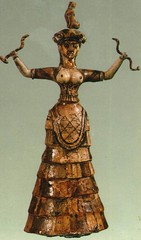The Minoans were primarily a mercantile people engaged in overseas trade. Their culture, from 1700 BC onward, shows a high degree of organization, says Wikipedia.
Objects of Minoan manufacture suggest there was a network of trade with mainland Greece (notably Mycenae), Cyprus, Syria, Anatolia, Egypt, Mesopotamia, and westward as far as the coast of Spain.
Minoan men wore loincloths and kilts. Women wore robes that had short sleeves and layered flounced skirts. These were open to the navel allowing their breasts to be left exposed, perhaps during ceremonial occasions.[citation needed] Women also had the option of wearing a strapless fitted bodice, the first fitted garments known in history.[citation needed] The patterns on clothes emphasized symmetrical geometric designs. It must be remembered that other forms of dress may have been worn of which we have no record.
The Minoan religion focused on female deities, with females officiating.[33] The statues of priestesses in Minoan culture and frescoes showing men and women participating in the same sports such as bull-leaping, lead some archaeologists to believe that men and women held equal social status.
Jump to: navigation, search
The Bull-Leaping Fresco from the Great Palace at Knossos, Crete
The bull-leaper, an ivory figurine from the palace of Knossos, Crete. The only complete surviving figure of a larger arrangement of figures. This is the earliest three dimensional representation of the bull leap. It is assumed that thin gold wires were used to suspend the figure over a bull.
Bull-leaping is a motif of Middle Bronze Age figurative art, notably of Minoan Crete, but also found in Hittite Anatolia, the Levant, Bactria and the Indus Valley.[2]
It is often interpreted as a depiction of a ritual performed in connection with bull worship. This ritual consists of an acrobatic leap over a bull; when the leaper grasps the bull's horns, the bull will violently jerk his head upwards giving the leaper the momentum necessary to perform somersaults and other acrobatic tricks or stunts. Bull leaping may have been a rite of passage for young men in Minoan culture.
Subscribe to:
Post Comments (Atom)





No comments:
Post a Comment